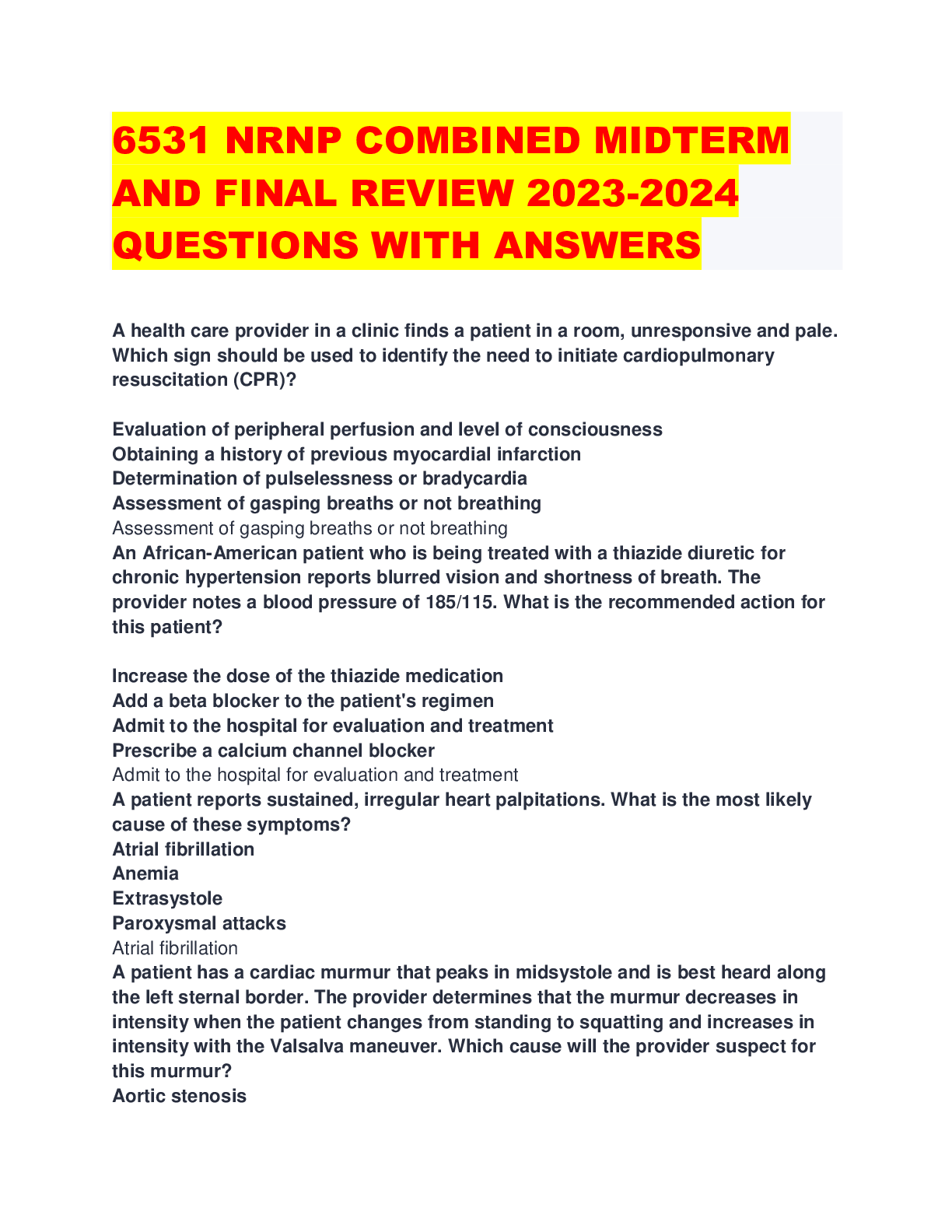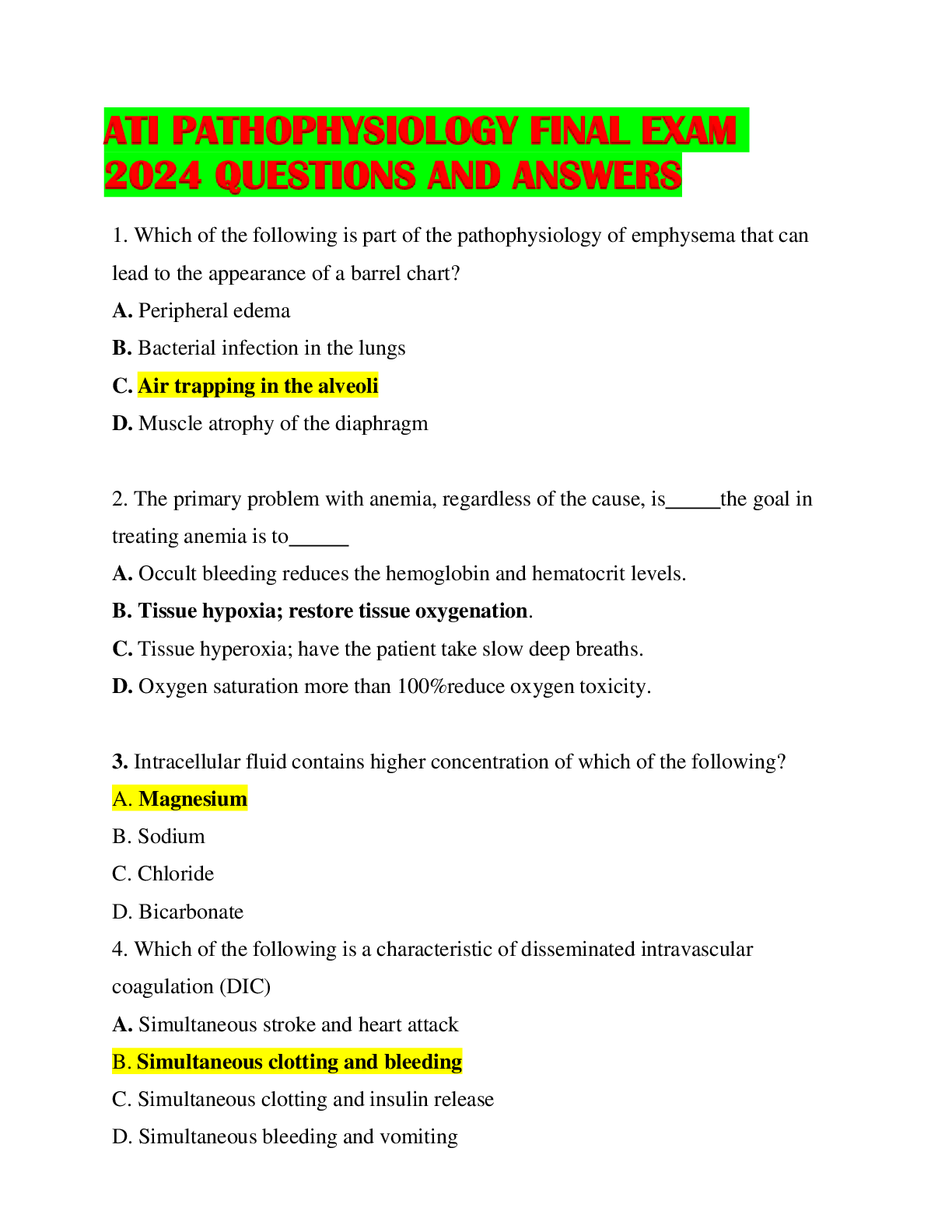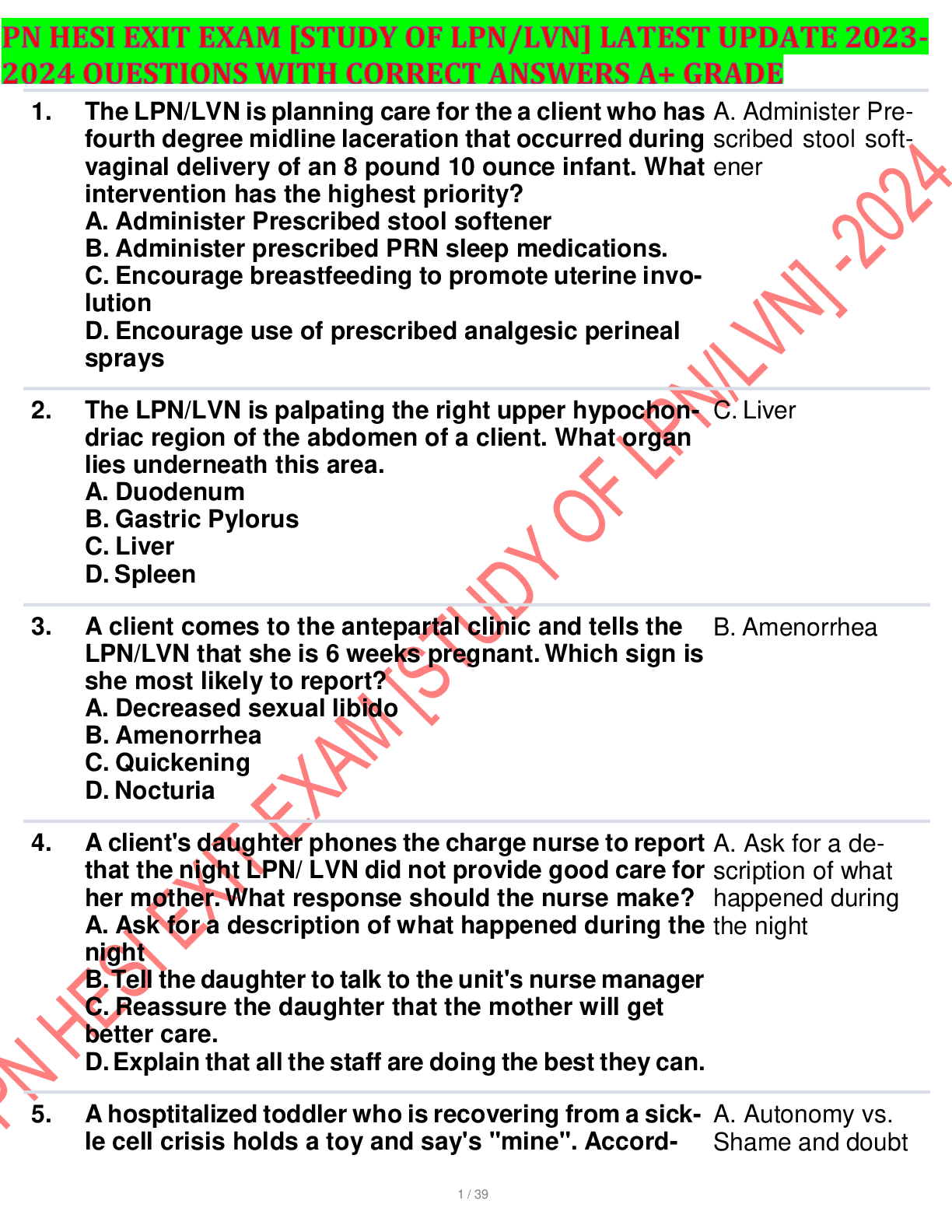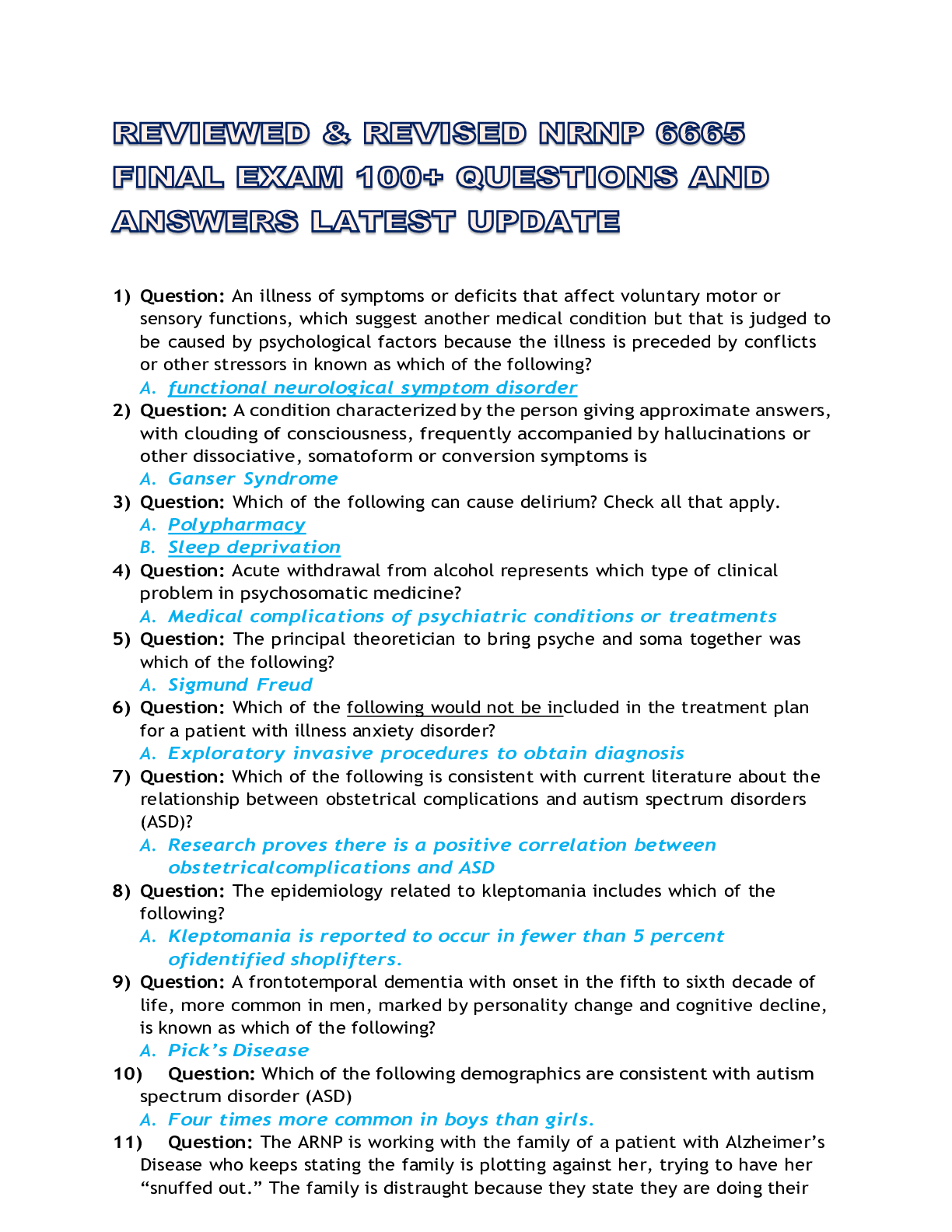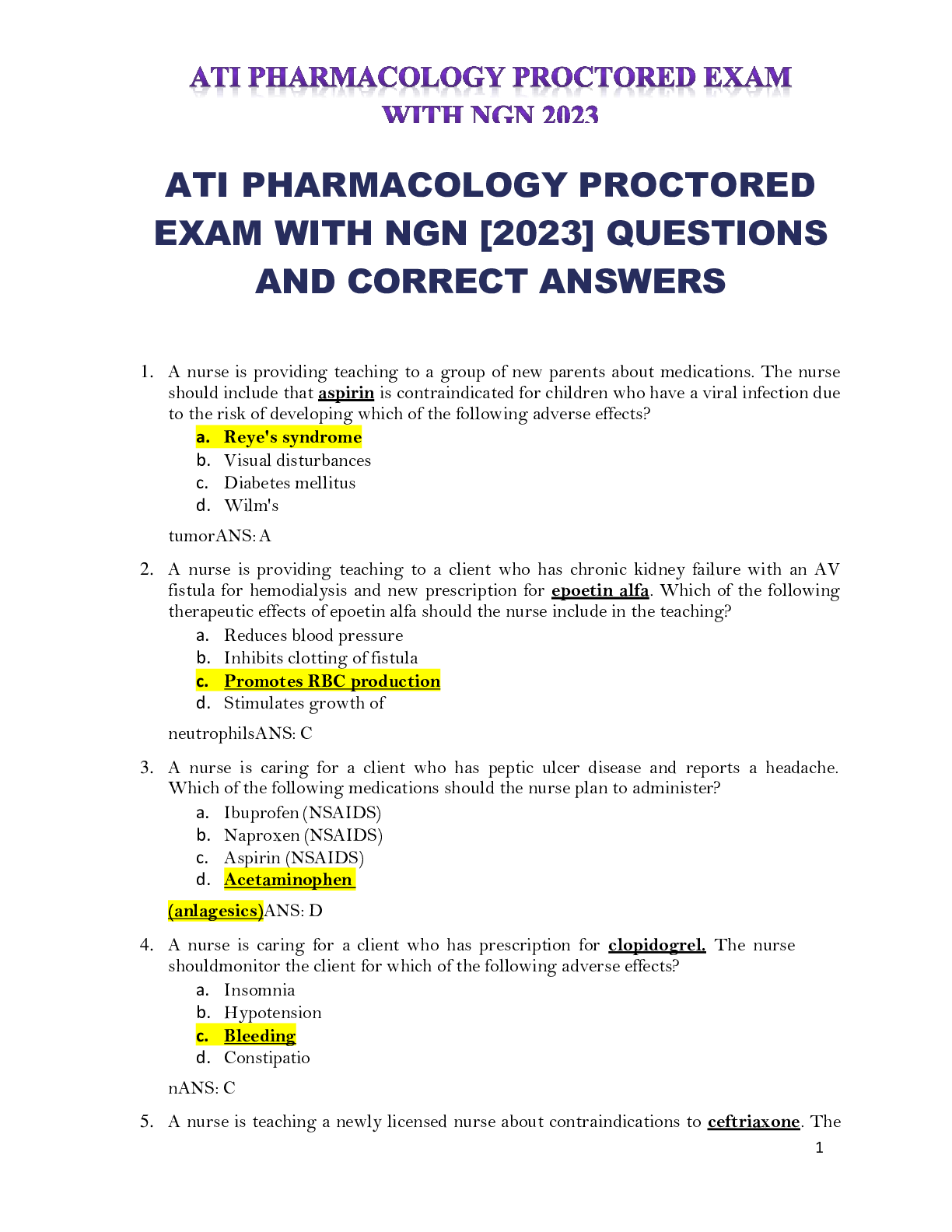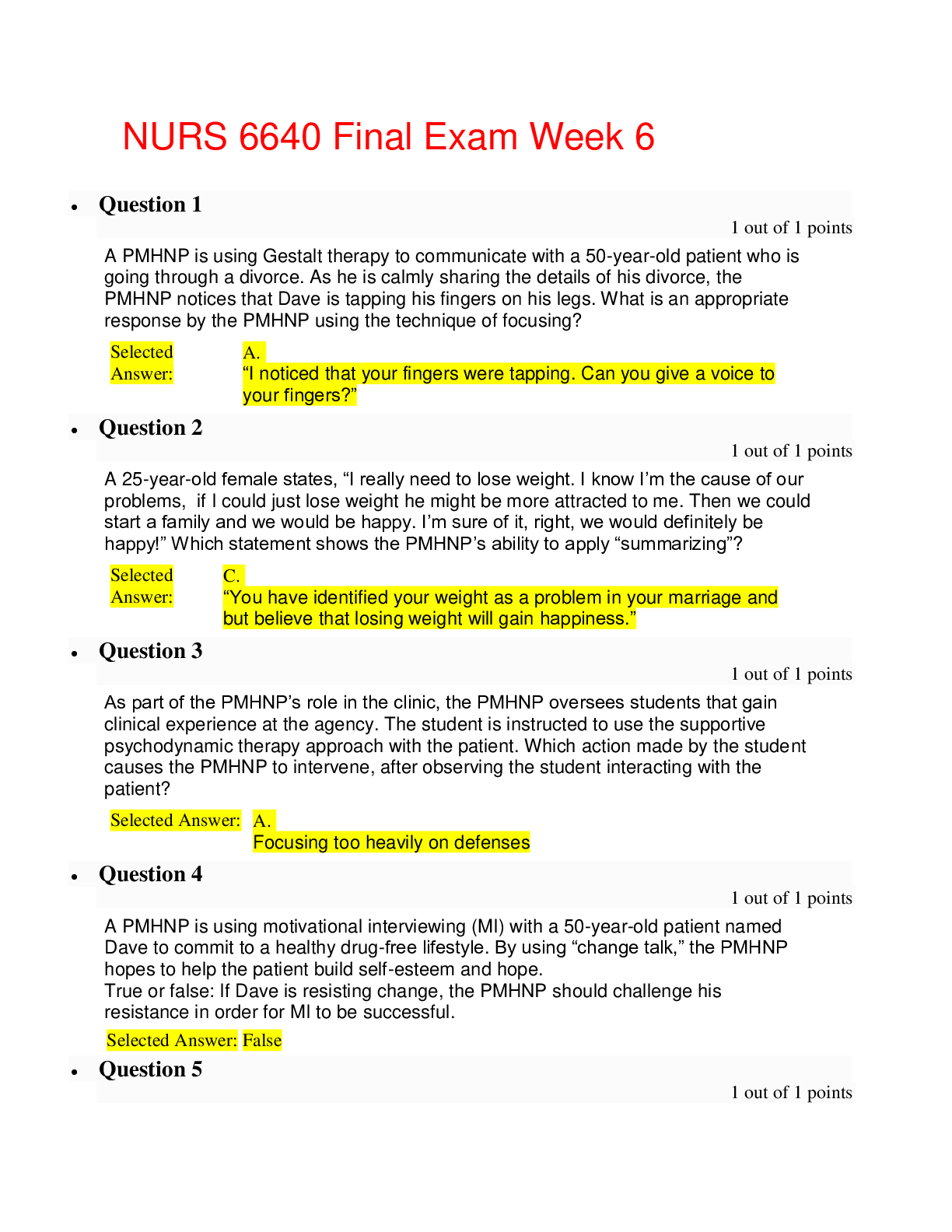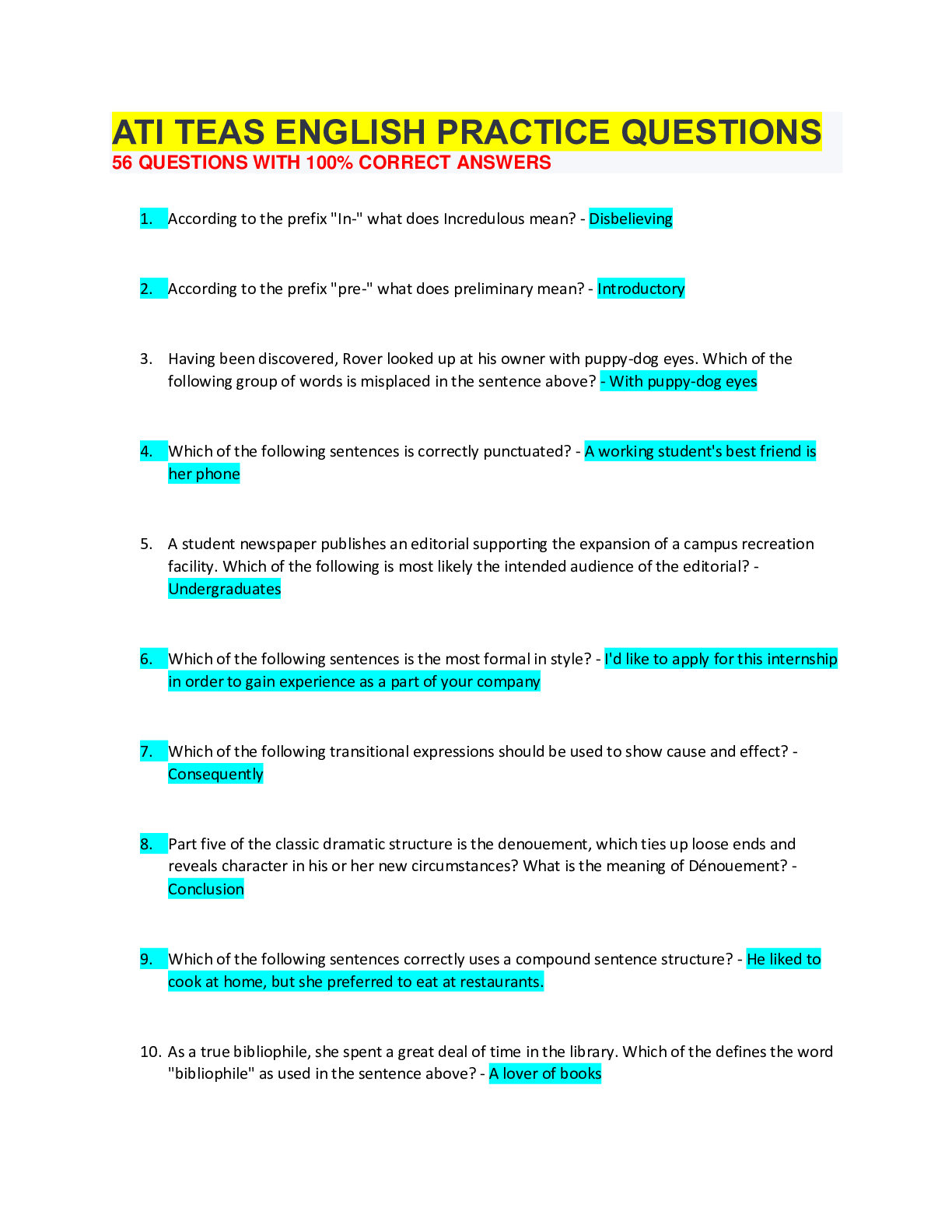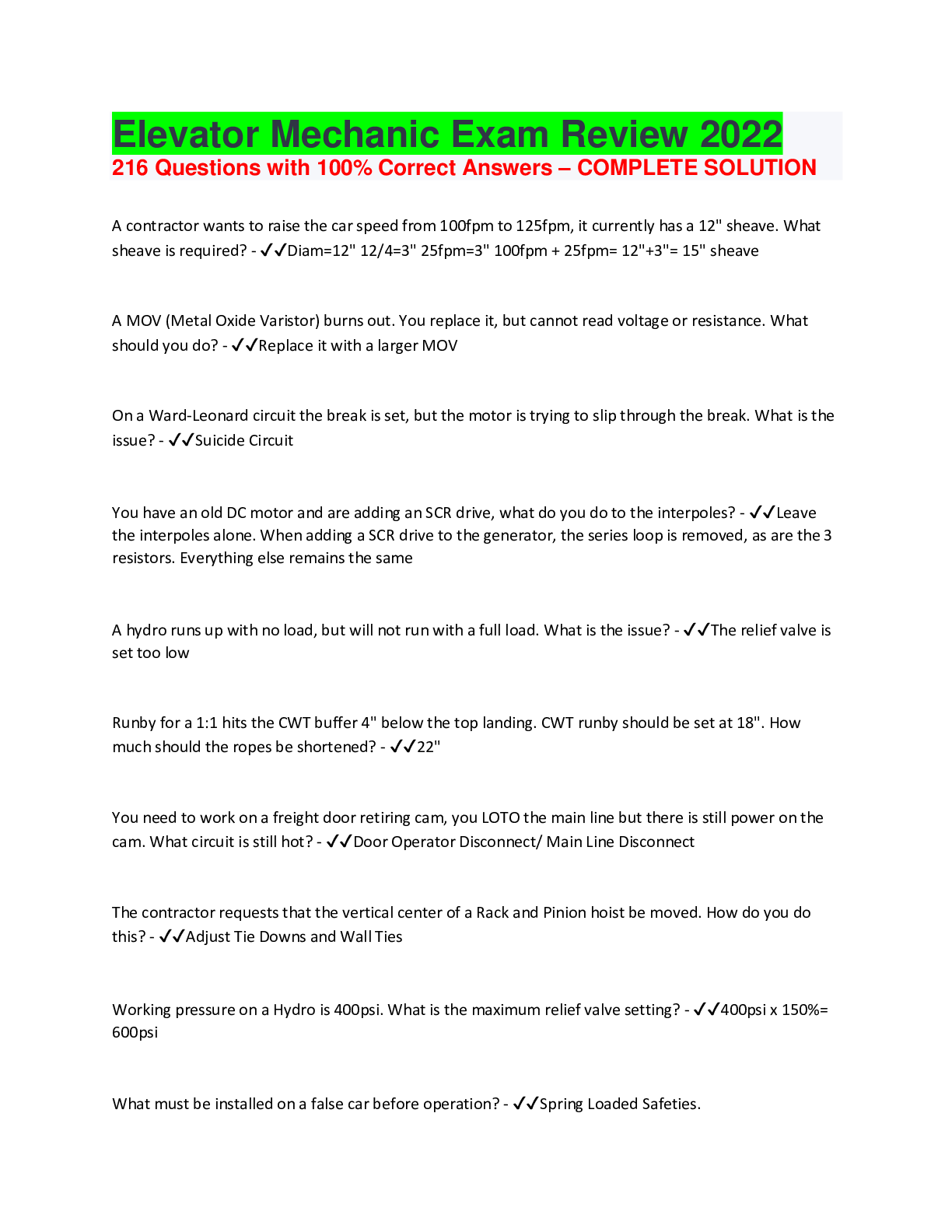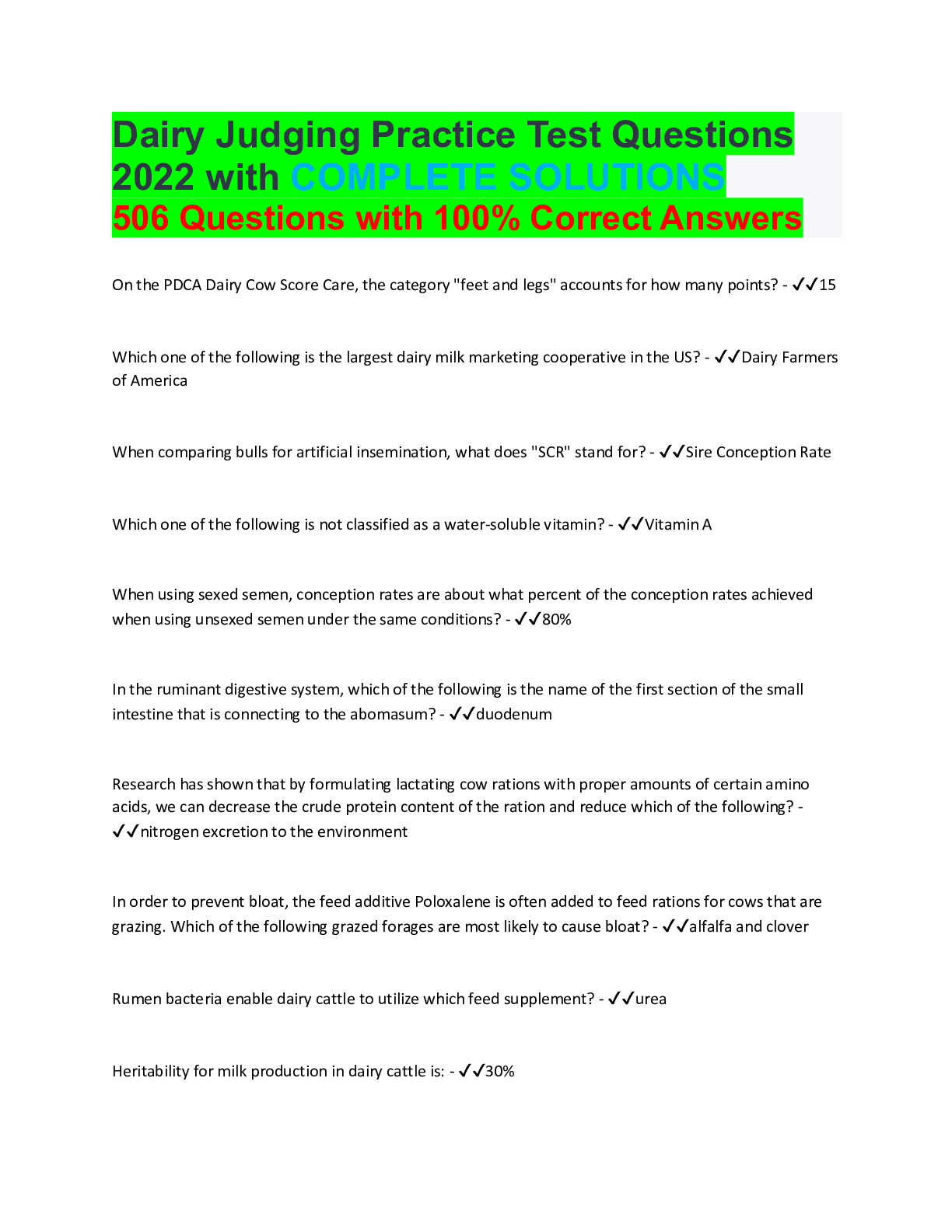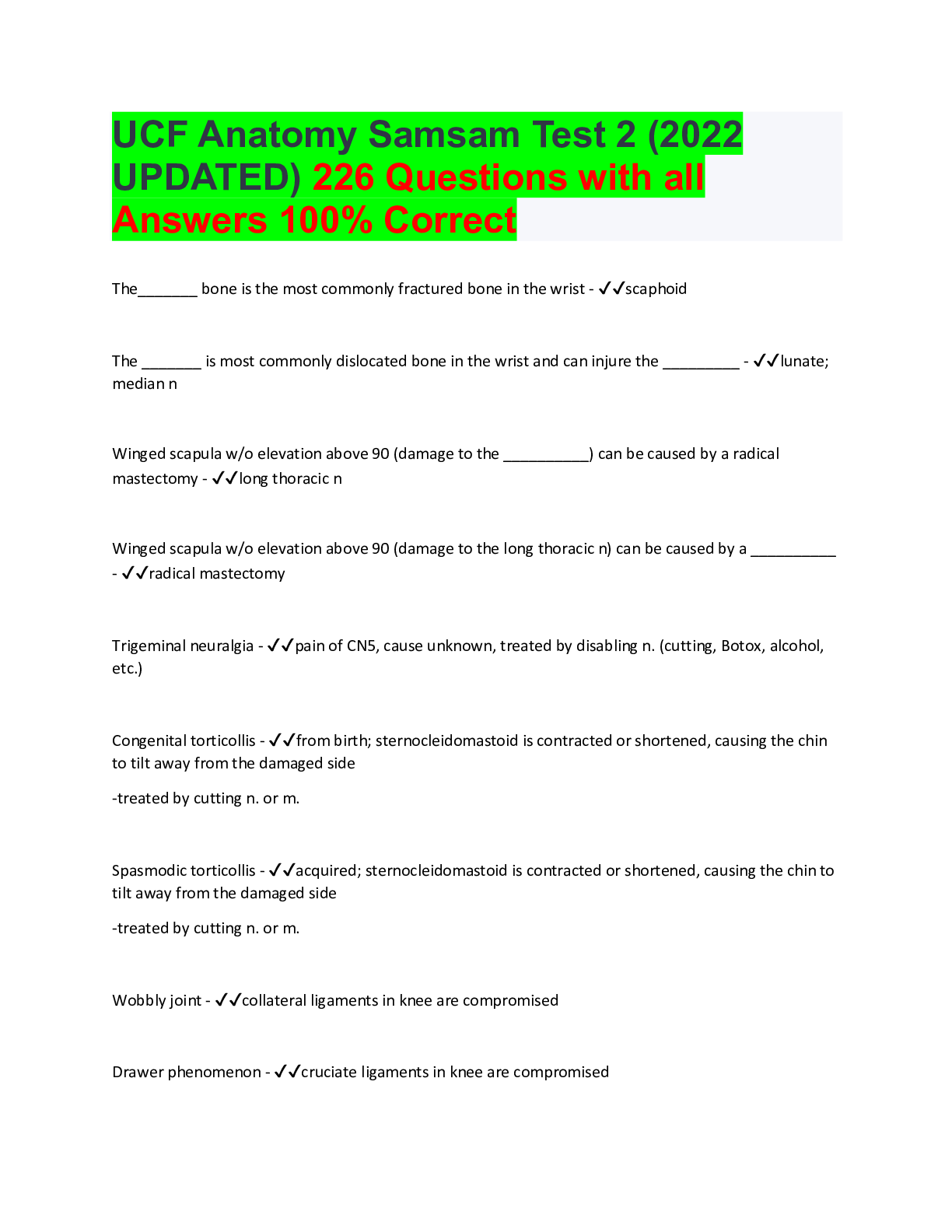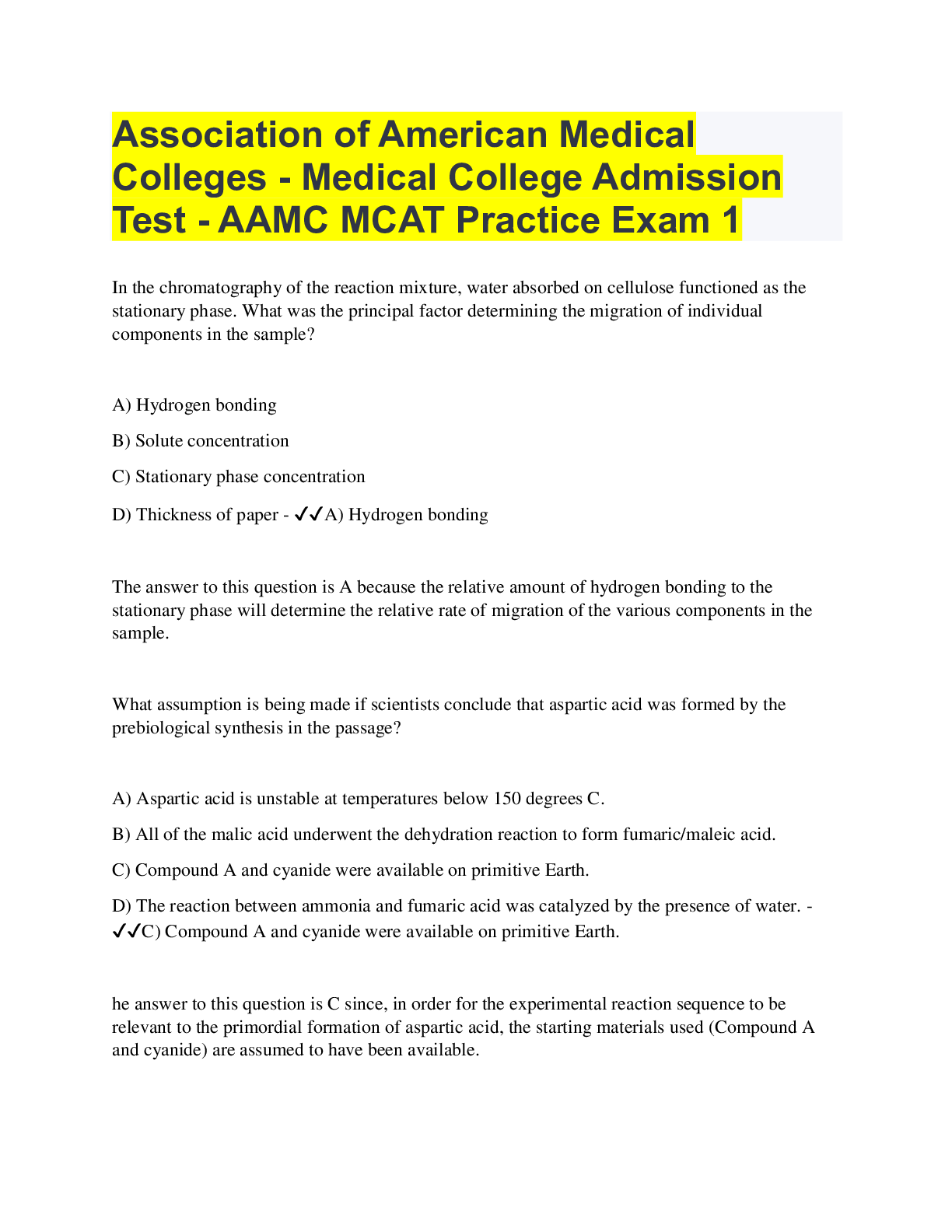ATI RN maternal newborn nursing > EXAM > MATERNAL NEWBORN WEEK1 TO WEEK 6 QUESTIONS WITH VERIFIED ANSWERS 2023-2024 A+ GRADE (All)
MATERNAL NEWBORN WEEK1 TO WEEK 6 QUESTIONS WITH VERIFIED ANSWERS 2023-2024 A+ GRADE
Document Content and Description Below
MATERNAL NEWBORN WEEK1 TO WEEK 6 QUESTIONS WITH VERIFIED ANSWERS 2023-2024 A+ GRADE Week 1 1. A nurse in a prenatal clinic is caring for a client who is at 7 weeks of gestation. The client reports... urinary frequency and asks if this will continue until delivery. Which of the following responses should the nurse make? a. "It's a minor inconvenience, which you should ignore." i. This is a nontherapeutic response that disregards the client’s concern and offers unwarranted reassurance. b. "In most cases it only lasts until the 12th week, but it will continue if you have poor bladder tone." i. The presence or absence of bladder tone has no bearing on urinary frequency during pregnancy. c. "There is no way to predict how long it will last in each individual client." i. This is a nontherapeutic response that does not provide appropriate information to the client. d. "It occurs during the first trimester and near the end of the pregnancy." i. Urinary frequency is due to increased bladder sensitivity during the first trimester and recurs near the end of the pregnancy as the enlarging uterus places pressure on the bladder. 2. A nurse is caring for an antepartum client whose laboratory findings indicate a negative rubella titer. Which of the following is the correct interpretation of this data? a. The client is not experiencing a rubella infection at this time. i. A negative rubella titer indicates the client is susceptible to the rubella virus. It does not indicate the presence or absence of a rubella infection. b. The client is immune to the rubella virus. i. A negative rubella titer indicates the client is susceptible to the rubella virus. c. The client requires a rubella vaccination at this time. i. Rubella vaccination during pregnancy is contraindicated because of possible injury to the developing fetus. d. The client requires a rubella immunization following delivery. i. A negative rubella titer indicates that the client is susceptible to the rubella virus and needs vaccination following delivery. Immunization during pregnancy is contraindicated because of possible injury to the developing fetus. Following rubella immunization, the client should be cautioned not to conceive for 1 month. 3. A nurse is instructing a woman who is contemplating pregnancy about nutritional needs. To reduce the risk of giving birth to a newborn who has a neural tube defect, which of the following information should the nurse include in the teaching? a. Limit alcohol consumption. i. Alcohol consumption has no effect on the incidence of neural tube defects. It is related to the incidence of other congenital defects and fetal alcohol syndrome (FAS) in newborns of clients who consume alcohol during pregnancy. b. Increase intake of iron-rich foods. i. Iron intake has no effect on the incidence of neural tube defects. A diet low in iron places a client who is pregnant at risk for preterm labor and postpartum hemorrhage. c. Consume foods fortified with folic acid. i. Increased consumption of folic acid in the 3 months prior to conception, as well as throughout the pregnancy, reduces the incidence of neural tube defects in the developing fetus. d. Avoid foods containing aspartame. i. Aspartame in the diet has no effect on the incidence of neural tube defects in a fetus. Clients who have phenylketonuria should be advised to avoid aspartame since it contains phenylalanine. 4. A nurse is caring for a client who is in her first trimester of pregnancy and asks the nurse if she can continue to exercise during pregnancy. Which of the following responses by the nurse is appropriate? a. "Exercising during pregnancy is not recommended." i. Physical activity during pregnancy improves circulation, rest, and relieves boredom. However, risky activities that require precise balance and coordination should be avoided. b. "Daily jogging for up to 30 minutes is fine throughout the pregnancy." i. While weight-bearing exercises might become uncomfortable in the last trimester, they are generally not contraindicated, providing the client stays hydrated and avoids becoming overheated for extended periods. c. "Activities that raise the body temperature, such as saunas and hot tubs, are safe until the third trimester." i. Prolonged or repeated elevations of maternal and fetal temperature can result in birth defects, especially during the first trimester of pregnancy. d. "It is recommended that pregnant clients limit their exercise routine to stretching activities on a mat several times a week." i. Daily moderate exercise throughout pregnancy is recommended. After the fourth month of pregnancy, clients should avoid exercising flat on their back due to the risk of vena cava syndrome. 5. A nurse is caring for a client who is at 6 weeks of gestation with her first pregnancy and asks the nurse when she can expect to experience quickening. Which of the following responses should the nurse make? a. "This will occur during the last trimester of pregnancy." i. A primigravida client should detect fetal movement earlier than the last weeks of pregnancy. b. "This will happen by the end of the first trimester of pregnancy." i. This is too early in the pregnancy for a primigravida client to detect fetal movement. c. "This will occur between the fourth and fifth months of pregnancy." i. Quickening is defined as the first time the client is able to feel her fetus move. In a primigravida client, this usually occurs at 18 weeks of gestation or later. In a multigravida client, this can occur as early as 14 to 16 weeks. d. "This will happen once the uterus begins to rise out of the pelvis." i. The uterus rises out of the pelvis at 12 to 14 weeks of gestation, which is too early for a primigravida client to notice fetal movement. 6. A nurse is caring for a client who is scheduled for a maternal serum-alpha-fetoprotein test at 15 weeks of gestation. The nurse provides which of the following explanations about this test to the client? a. This test assesses fetal lung maturity. b. It assesses various markers of fetal well-being. c. This test identifies an Rh incompatibility between the mother and fetus. d. It is a screening test for spinal defects in the fetus. i. The maternal serum alpha-fetoprotein (MSAFP) screening test is used to identify suspected neural tube defects (NTDs) and abdominal wall defects. These include spina bifida, microcephaly, and anencephaly. This tool is the basis for further testing, such as amniocentesis and specialized ultrasounds. 7. A nurse is caring for a client who has a positive pregnancy test. The nurse is teaching the client about common discomforts in the first trimester of pregnancy as well as warning signs of potential danger. The nurse should instruct the client to call the clinic if she experiences which of the following manifestations? a. Leukorrhea b. Urinary frequency c. Nausea and vomiting d. Facial edema i. Facial edema is a warning sign of a hypertensive condition or preeclampsia and should be reported immediately to the provider. 8. A nurse in a prenatal clinic is caring for a client who is pregnant and asks the nurse for her estimated date of birth (EDB). The client's last menstrual period began on July 27. What is the client's EDB? (State the date in MMDD. For example, July 27 is 0727). a. 0504 i. Using Nägele's rule, the nurse subtracts three months from the date of the last menstrual period, then adds 7 days. July minus 3 months equals April. There are 30 days in April, so 27 + 7 = May 4. The client's EDB is May 4, which would be written as 0504 in the MMDD format. 9. A nurse is providing preconception counseling for a client who is planning a pregnancy. Which of the following supplements should the nurse recommend to help prevent neural tube defects in the fetus? a. Calcium b. Iron i. Pregnant clients need adequate amounts of calcium to promote the formation of the fetal skeleton; however, taking calcium supplements prior to conception will not help prevent neural tube defects. i. Pregnant clients need adequate amounts of iron to promote maternal hemoglobin formation and fetal iron storage in the liver; however, taking iron supplements prior to conception will not help prevent neural tube defects. c. Vitamin C i. Pregnant clients need adequate amounts of vitamin C to promote tissue formation and growth; however, taking vitamin C supplements prior to conception will not help prevent neural tube defects. d. Folic acid i. Adequate amounts of folic acid before conception and during the first trimester of pregnancy are necessary for fetal neural tube development. This vitamin helps prevent spina bifida and other neurological disorders. 10. A nurse in a prenatal clinic is completing a skin assessment of a client who is in the second trimester. Which of the following findings should the nurse expect? (Select all that apply.) a. Eczema b. Psoriasis c. Linea nigra d. Chloasma e. Striae gravidarum 11. A nurse is assessing a client who is in active labor and notes that the presenting part is at 0 station. Which of the following is the correct interpretation of this clinical finding? a. The fetal head is in the left occiput posterior position. b. The largest fetal diameter has passed through the pelvic outlet. c. The posterior fontanel is palpable. d. The lowermost portion of the fetus is at the level of the ischial spines. i. The presenting part is at 0 station when its lowermost portion is at the level of an imaginary line drawn between the client's ischial spines. Levels above the ischial spines are negative values: -1, -2, -3. Levels below the ischial spines are positive values: +1, +2, +3 12. A nurse is providing teaching about nutrition to a client at her first prenatal visit. Which of the following statements by the nurse should be included in the teaching? a. "You will need to increase your calcium intake during breast feeding." i. The need for calcium during pregnancy and lactation remains the same as for female clients who are not pregnant. b. "Prenatal vitamins will meet your need for increased vitamin D during pregnancy." i. The need for vitamin D during pregnancy does not increase. c. "Vitamin E requirements decline during pregnancy due to the increase in body fat." i. The need for vitamin E during pregnancy remains the same as for female clients who are not pregnant. d. "You will need to double your intake of iron during pregnancy." i. During pregnancy, the need for iron increases to allow transfer of the appropriate amounts to the fetus and to support expansion of the client’s red blood cell volume. 13. A nurse is completing a health history for a client who is at 6 weeks of gestation. The client informs the nurse that she smokes one pack of cigarettes per day. The nurse should advise the client that smoking places the client’s newborn at risk for which of the following complications? a. Hearing loss i. Hearing loss in the newborn is related to congenital rubella syndrome and cytomegalovirus infection during pregnancy. b. Intrauterine growth restriction i. Clients who smoke place their newborns and themselves at risk for diverse complications, including fetal intrauterine growth restriction, placental abruption, placenta previa, preterm delivery, and fetal death. c. Type 1 diabetes mellitus i. A newborn’s risk for development of type 1 diabetes mellitus is associated with a family history of diabetes and an autoimmune process. d. Congenital heart defects i. Congenital alterations in the newborn, such as ventricular septal defects and central nervous system malfunctions, are associated with maternal alcohol abuse. 14. A nurse is caring for a client at the first prenatal visit who has a BMI of 26.5. The client asks how much weight she should gain during pregnancy. Which of the following responses should the nurse make? a. "It would be best if you gained about 11 to 20 pounds." i. Clients who are obese, having a BMI greater than 30, should be advised that the recommended weight gain is 5 to 9 kg (11 to 20 lb). This client is not obese. b. "The recommendation for you is about 15 to 25 pounds." i. Clients who are overweight, having a BMI of 25 to 29.9, should be advised that the recommended weight gain is 7 to 11.5 kg (15 to 25 lb). The pattern of weight gain is also important, with minimal gain in the first trimester. c. "A gain of about 25 to 35 pounds is recommended for you." i. Clients who have a single fetus and a BMI of 18 to 24.9, the normal range, should gain 11.5 to 16 kg (25 to 35 lb) during pregnancy. This client’s BMI indicates that she is overweight. d. "A gain of about 1 pound per week is the best pattern for you." i. Clients who are underweight, having a BMI less than 18.5, are advised that a weight gain of 0.5 kg (1.1 lb) per week during the second and third trimesters is appropriate. This client‘s BMI indicates that she is overweight. 15. A nurse is preparing to measure the fundal height of a client who is at 22 weeks of gestation. At which location should the nurse expect to palpate the fundus? a. 3 cm above the umbilicus i. This level indicates a pregnancy at more than 22 weeks of gestation. b. Slightly above the umbilicus i. At 22 weeks of gestation, the fundal height should be just above the level of the umbilicus. The distance in centimeters from the symphysis pubis to the top of the fundus is a gross estimate of the weeks of gestation. c. Slightly below the umbilicus i. This level indicates a pregnancy at less than 22 weeks of gestation. d. 3 cm below the umbilicus i. This level indicates a pregnancy at less than 22 weeks of gestation. 16. A nurse is caring for a client who is at 18 weeks of gestation. The client tells the nurse that she felt fluttering movements in her abdomen 3 days ago. The nurse should interpret this finding as which of the following? a. Ballottement i. Ballottement is the passive movement of the fetus when the examiner performs a vaginal examination and gently pushes on the fetus with a fingertip. b. Lightening i. Lightening is the beginning of fetal descent and engagement in the maternal pelvis during the final weeks of a term pregnancy. c. Quickening i. Clients describe quickening as a fluttering sensation, which can be felt as early as the 14th week of gestation. It reflects fetal movement. d. Chloasma i. Chloasma is the presence of a brown hyperpigmentation over the forehead, nose, and cheeks of a client who is pregnant. It is due to an increased level of melatonin, reflecting the hormonal changes of pregnancy. 17. A nurse in a prenatal clinic is caring for a client who is at 12 weeks gestation. The client asks about the cause of her heartburn. Which of the following responses should the nurse make? a. Retained bile in the liver results in delayed digestion. i. Retention of bile can result in its thickening, which can lead to gallstones during pregnancy. b. Increased estrogen production causes increased secretion of hydrochloric acid. i. Increased estrogen production causes decreased secretion of hydrochloric acid. c. Pressure from the growing uterus displaces the stomach. i. At 12 weeks of gestation, the uterus is not large enough to place pressure on the stomach. d. Increased progesterone production causes decreased motility of smooth muscle. i. Increased progesterone production causes a relaxation of the cardiac sphincter of the stomach and delayed gastric emptying, which can result in heartburn. 18. A nurse is teaching about fetal development to a group of clients in the antenatal clinic. Which of the following statements should the nurse include in the teaching? a. "The baby’s heart beat is audible by a Doppler stethoscope at 12 weeks of pregnancy." [Show More]
Last updated: 2 months ago
Preview 1 out of 48 pages
Instant download
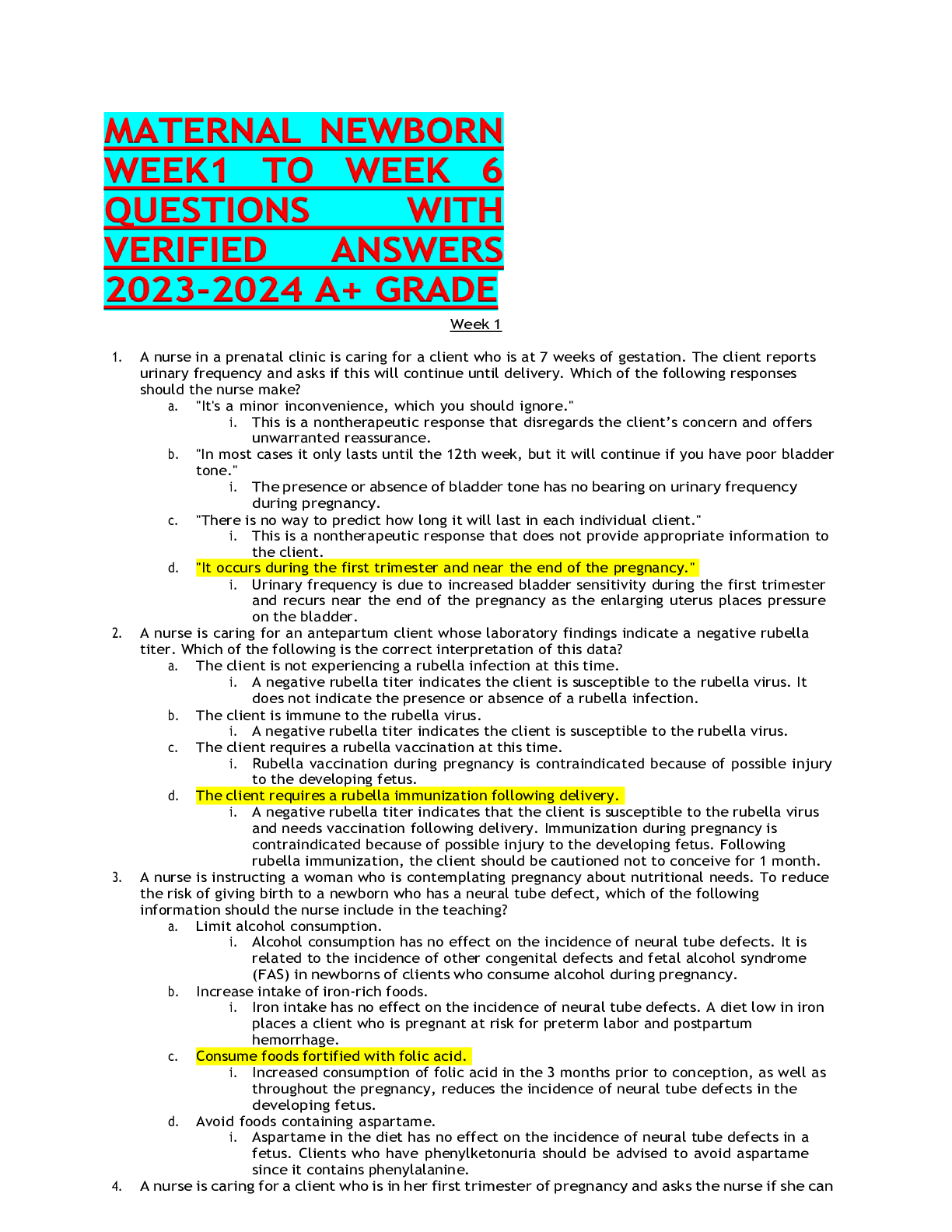
Buy this document to get the full access instantly
Instant Download Access after purchase
Add to cartInstant download
Reviews( 0 )
Document information
Connected school, study & course
About the document
Uploaded On
Mar 28, 2024
Number of pages
48
Written in
Additional information
This document has been written for:
Uploaded
Mar 28, 2024
Downloads
0
Views
23

